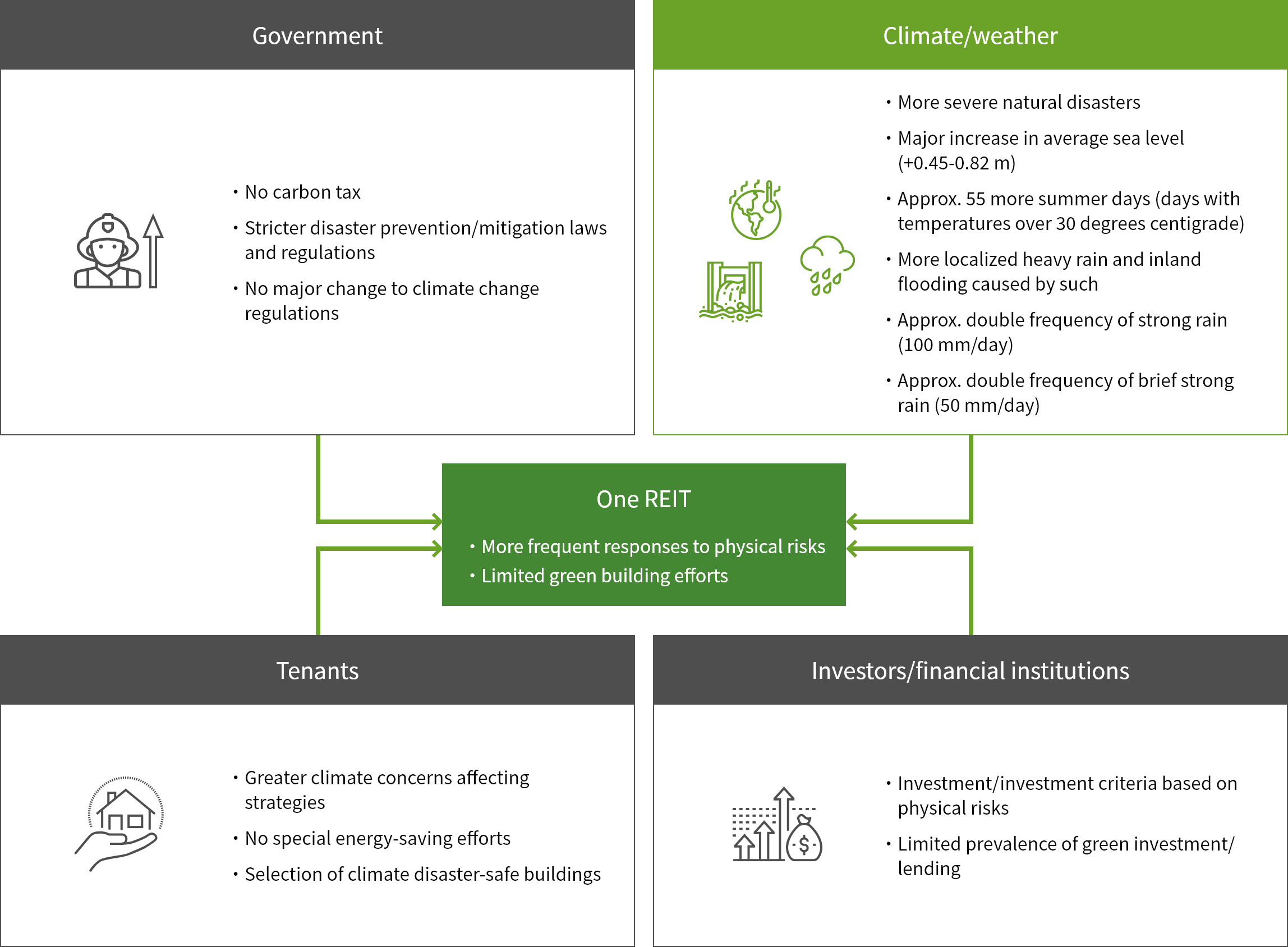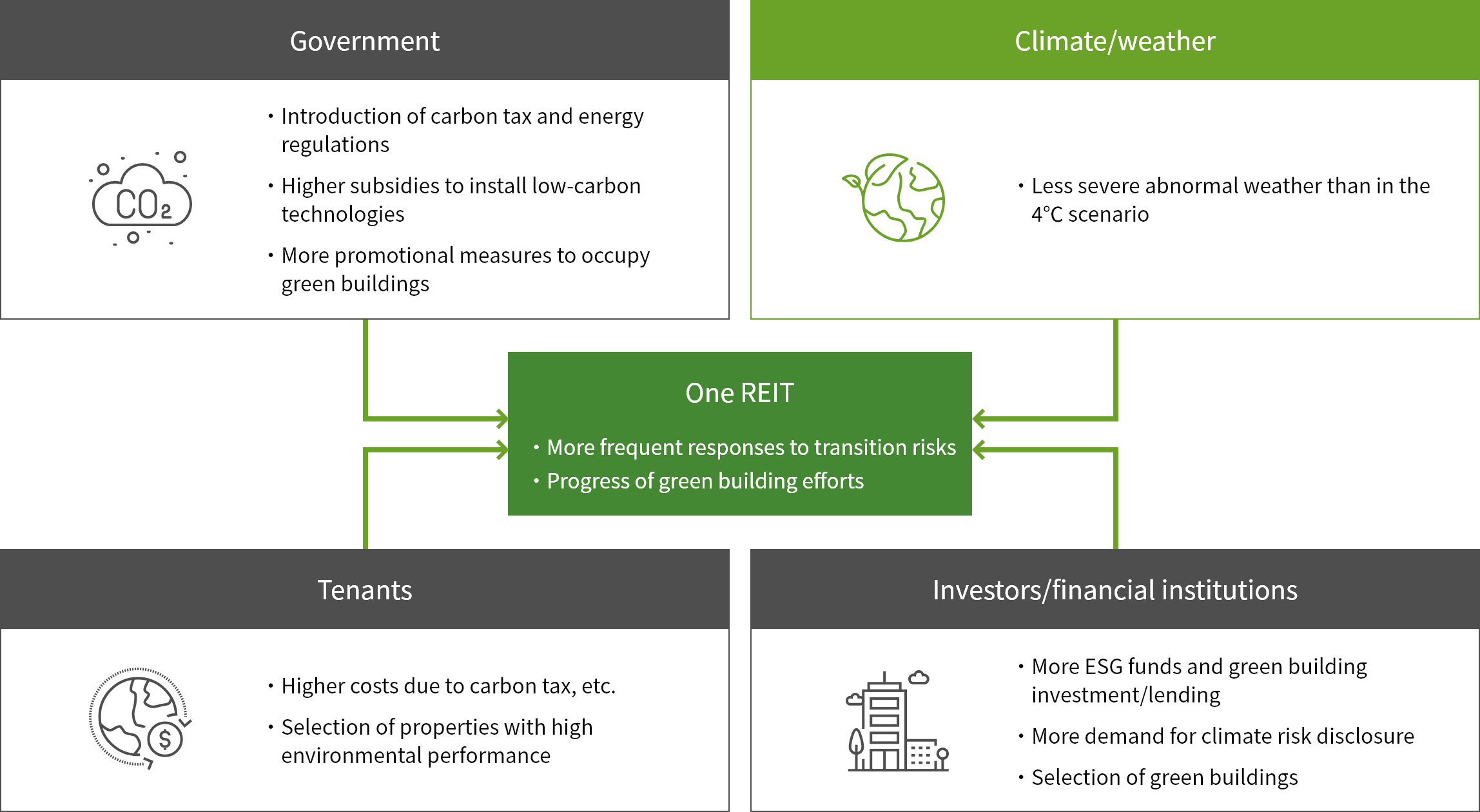Response to Climate Change
As indicated in the Paris Agreement (2015) and elsewhere, climate change is a scientific fact and is recognized as a material issue that will cause dramatic changes in the natural environment and social structure and have a significant impact on the overall management and business of One REIT and the Asset Management Company.
Based on the recognition that climate change is a global issue, One REIT aims to realize a decarbonized society and build a strong, climate change-resilient business foundation by managing and reducing energy consumption, greenhouse gas emissions, water consumption and waste volume, and enhancing severe disaster resiliency.
Support for TCFD (Task Force on Climate-related Financial Disclosures) Recommendations
In April 2022, Mizuho Realty One Co., Ltd. (MONE), which is the Asset Management Company's parent company announced its support for the TCFD recommendations and joined the TCFD Consortium, an organization of Japanese companies that have endorsed them.
One REIT and the Asset Management Company also recognize the importance of disclosing information on climate-related risks and opportunities, and are committed to addressing this and promoting further disclosure.
The TCFD published its final report in June 2017, recommending that companies disclose the following items on climate change-related risks and opportunities.
Disclosure Items Recommended by TCFD
This table can be scrolled sideways.
| Disclosure Item | Disclosure Details |
|---|---|
| Governance | Disclose the organization's governance around climate-related risks and opportunities. |
| Strategy | Disclose the actual and potential impacts that climate-related risks and opportunities will have on the organization’s businesses, strategy, and financial planning. |
| Risk management | Disclose the process which the organization uses to identify, assess, and manage climate-related risks. |
| Indicators and targets | Disclose the indicators and targets used to assess and manage relevant climate-related risks and opportunities. |

Basic Policy and Commitments
The Asset Management Company supports the international goals set forth in the Paris Agreement and will continuously work to reduce greenhouse gas emissions in order to contribute to the mitigation of climate change. In addition, in accordance with MONE, which endorses the TCFD recommendations, we will disclose climate-related information to our stakeholders while following the disclosure framework.
Governance
We have the following structure in place to address climate-related risks and opportunities.
(1) Board of Directors
The Board of Directors makes decisions on the formulation of mid- to long-term or annual plans for sustainability in the Asset Management Company's corporate operations and on other important sustainability matters.
(2) Investment Committee
The Investment Committee makes decisions on important sustainability matters for One REIT.
(3) Sustainability Promotion Council
The Sustainability Promotion Council is an advisory body to the Chief Executive Officer and discusses matters related to the Asset Management Company's corporate operations and the setting and monitoring of targets for sustainability initiatives of the REITs designated by the Chief Executive Officer.
(4) Sustainability Promotion Officer
The Sustainability Promotion Officer is the Chief Executive Officer, who oversees the sustainability initiatives of the Asset Management Company and its REIT.
(5) MONE Sustainability Committee
An advisory body to MONE's Board of Directors, MONE's Sustainability Committee deliberates on the MONE Group's sustainability policy, presents targets for the MONE Group to the Asset Management Company's Sustainability Promotion Officer, and monitors them. However, MONE is not involved in the Asset Management Company's decision-making on investment management matters for REITs which entrust their asset management to the Asset Management Company (regardless of the contract name or asset type). In addition, the MONE Group's Chief Climate Officer (MONE's President and Representative Director) can ask the Asset Management Company's Sustainability Promotion Officer to report to MONE's Sustainability Committee on the status of climate-related issues. (With respect to information concerning the REITs for which the Asset Management Company manages the assets, this is limited to information that the Asset Management Company deems may be provided without any problems, such as public information in the case of One REIT.)
Strategy
One REIT has analyzed scenarios in line with the TCFD recommendations in order to understand the risks and opportunities that climate change poses to the REIT and examine their impact.
Scenario Analysis Assumptions
(1) Time horizon
For the scenario analysis, we divided the timing in which financial impacts of climate-related risks and opportunities become more apparent into the following three time periods.
This table can be scrolled sideways.
| Period | Definition |
|---|---|
| Short term | By 2025 |
| Medium term | By 2030 |
| Long term | By 2050 |
(2) Information Sources Referenced
One REIT analyzed scenarios using future climate projections published by various international organizations, etc. as its main sources of information (shown below).
Note that climate-related risks can be broadly classified as "transition risks" or "physical risks," and may bring not only risks but also new business opportunities.
This table can be scrolled sideways.
| Climate-related risks | Main information sources referenced | |
|---|---|---|
| Transition risks | Business impacts resulting from social/economic transition to low/zero carbon |
|
| Physical risks | Business impacts resulting from ongoing climate change from previous patterns and phenomena |
|
(3) Scenarios based on the main information sources
Based on the Paris Agreement, our base cases for analysis were the 4°C scenario and the 1.5°C scenario, as summarized below.
4°C Scenario (sources referenced: STEPS, RCP8.5)
A future in which climate change mitigation measures are insufficient and GHG emissions continue to rise, resulting in a large temperature increase. This scenario has high physical risk and low transition risk.

1.5°C Scenario (sources referenced: NEZ2050, RCP2.6)
A future in which zero-carbon social policies, emission controls and technology investment proceed more than in the present situation toward achieving the Paris Agreement targets, limiting temperature increase. This scenario has low physical risk and high transition risk.

Summary of Scenario Analysis
Based on the abovementioned assumptions, One REIT has examined climate-related risk and opportunity factors as well as financial implications and risk management/response measures that can be expected, as summarized below.
This table can be scrolled sideways.
| Risk category | Risk/opportunity factors | Type | Financial impacts | Risk Management/Response Measures | Severity/timeframe of maximum financial impacts | |||
|---|---|---|---|---|---|---|---|---|
| 4℃ | 1.5℃ | |||||||
| Transition Risks and Opportunities | Policy and law |
Stricter energy laws/regulations | ||||||
| Introduction of carbon tax | Risk |
|
|
Medium term | ||||
| Low | Medium | |||||||
| Stricter building energy-saving standards | Risk |
|
|
Medium term | ||||
| Medium | High | |||||||
| Opportunity |
|
|
Medium term | |||||
| Low | High | |||||||
| Expanded/mandatory energy-saving ratings | Risk |
|
|
Medium term | ||||
| Low | Low | |||||||
| Opportunity |
|
Medium term | ||||||
| Low | Low | |||||||
| Technology | Evolution/spread of renewable energy/energy-saving technology | Risk |
|
|
Short term | |||
| Low | Medium | |||||||
| Opportunity |
|
|
Medium term | |||||
| Low | Medium | |||||||
| Market/reputation | Higher utility bills (including external procurement of renewable energy) | Risk |
|
|
Medium term | |||
| Medium | Low | |||||||
| Change in tenant demand/real estate transaction demand | Risk |
Due to a slow response to climate change:
|
|
Medium term | ||||
| Low | Medium | |||||||
| Green building appeal to tenants/users | Opportunity |
|
|
Medium term | ||||
| Low | Medium | |||||||
| Worse fundraising terms for market participants (bond issuers) not responding to climate change | Risk |
|
|
Short term | ||||
| Low | Low | |||||||
| Appeal to current investors/lenders, acquisition of new investors/lenders | Opportunity |
|
|
Short term | ||||
| Low | Low | |||||||
| Physical Risks and Opportunities | Acute | More water damage/landslides due to severer storm and flood damage | Risk |
|
|
Long term | ||
| High | Medium | |||||||
| Opportunity |
|
Short term | ||||||
| High | Medium | |||||||
| Chronic | Flooding of low-elevation properties due to sea level rise | Risk |
|
|
Long term | |||
| Low | Low | |||||||
(Note) The period of highest impact is until 2025 for short term, 2030 for medium term and 2050 for long term.
Risk Management
The Asset Management Company's Sustainability Promotion Officer manages identified and assessed climate-related risks and opportunities and promotes resilience initiatives to reduce business risks and realize value creation opportunities to ensure steady, sustainable earnings over the long term. The management process for climate-related risk and opportunity factors is as follows:
- The Sustainability Promotion Officer directs the Sustainability Promotion Council to consider the development of countermeasures for climate-related risks and opportunities that are high-priority in business and financial plans.
- The Sustainability Promotion Council's proposed measures are deliberated on and approved by the institutions specified in the Basic Policy on Sustainability Initiatives based on their content, and are then implemented.
- The Sustainability Promotion Officer also instructs the Asset Management Company to consider climate-related risks that are important in business and financial plans for its regulations.
Indicators and Targets
The following indicators and targets are used in the process of managing climate-related risks and opportunities.
| Indicator | Target | |
|---|---|---|
| 1 | Reduction of greenhouse gas emission (intensity) | (From FY2014) 40% (FY2030) 100% (FY2050) |
| 2 | Reduction of water consumption (intensity) | (From FY2014) 10% (FY2030) |
| 3 | Percentage of portfolio that is green building-certified (by total floor area) | 90% (FY2030) |
